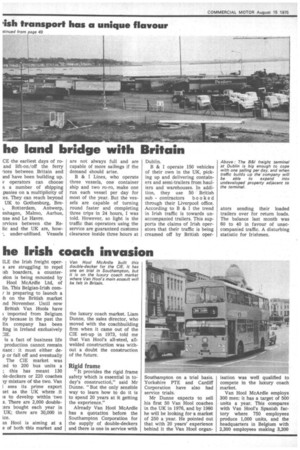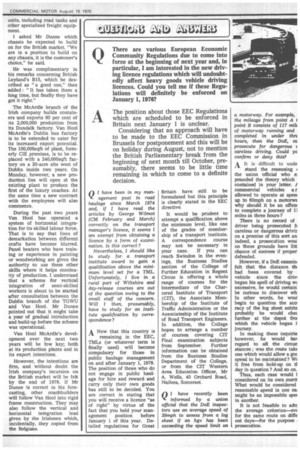he Irish coach invasion
Page 52

Page 53

If you've noticed an error in this article please click here to report it so we can fix it.
ILE the Irish freight opers are struggling to repel ,sh boarders, a countersion is being mounted by Hool McArdle Ltd, of lin. This Belgian-Irish cornr is preparing to launch a h on the British market .nd November. Until now British Van Hoots have imported from Belgium fly because in the past the lin company has been ling in Ireland exdlusively
7,1E.
is a fact of 'business life production cannot remain tanec : it must either dep or fall off and eventually The CIE market was e d to 200 bus units a ; this has meant 130 v1e-deckers or 220 coaches ly mixture of the two. Van sees its prime export cet as the UK where it to develop within two s. There are 2,000 double:ers bought each year in UK; there are 30,000 in ice.
in Hool is aiming at -a e of both this market and the luxury coach market. Liam Dunne, the sales director, who moved with the coachbuilding firm when it came out of the CIE set-up in 1973, told me that Van Hoot's all-steel, allwelded construction was without a doubt the construction of the future.
Rigid frame
"It provides the rigid frame safety which is essential in today's construction," said Mr Dunne. "But the only sensible way to learn how to do it 'is to spend 20 years at it getting the experience."
Already Van Hodl McArdle has a quotation before the Southampton Corporation for the supply of double-deckers and there is one in service with Southampton on a trial basis. Yorkshire PTE and Cardiff Corporation have also had service trials.
Mr Dunne expects to sell his first 50 Van Hoot coaches in the UK in 1976, and by 1980 he will be looking for a market of 250 a year. He pointed out that with 20 years' experience behind it the Van Hoot organ isation was well qualified to compete in the luxury coach market.
Van Hoot McArdle employs 300 men: it has a target of 500 units a year. This compares with Van Hool's Spanish factory where 750 employees produce 1,000 units, and the headquarters in Belgium with 2,300 employees making 3,200 units, including road tanks and other specialised freight equipment.
I asked Mr Dunne which chassis he expected to build on for the British market. "We are in a position to build on any chassis, it is the customer's choice," he said.
He was complimentary in his remarks concerning British Leyland's B15, which he described as "a good one," then added : "It has taken them a long time, but finally they have got Ft right."
The McArdle branch of the Irish company builds containers and exports 90 per cent of its 2,000,000 production from its Dundalk factory. Van Hool McArdIe's Dublin bus factory is to be extended to cater for its increased export potential. The 100,000sqfit of plant, formerly CIE premises, is to be replaced with a 240,000sqft factory on a 20-acre site west of Dublin inside two years. On Monday, however, a new production line will open at the existing plant to produce the first of the luxury coaches. At the same time a new contract with the employees will also commence.
During the past two ,years Van Hopi has operated a system of horizontal integration for its skilled labour force. That is to say that lines of demarkation between different crafts have become blurred. Panel beaters who have training or experience in painting or woodworking are given the authority to use these other skills where it helps continuity of production. I understand that a scheme for vertical integration of semi-skilled workers is about to be started after consultation between the Dublin ,branch of the TGWU and Van Hool. Mr Dunne pointed out that it might take a year of gradual introduction and build-up before the scheme was operational.
Van Hool McArdle's development over the next two years will be low key; both at its production plants and in its export intentions.
However, the intentions are firm, and without doubt the Irish company's incursion on the British market will be felt by the end of 1978. If Mr Dunne is correct in his forecasting, other coachbuilders will follow Van Hool into rigid frame construction. They may also follow the vertical and horizontal integration lead given by the Irishmen which, incidentally, they copied from the Belgians.




































































































